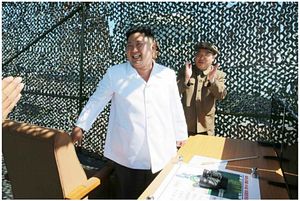On Tuesday, North Korea’s state-run news agency reported that the country had successfully tested a new rocket engine. The test is the first major demonstration of missile-related technology since North Korea’s fifth nuclear test on September 9. The test also marks Kim Jong-un’s first appearance in public since the nuclear test.
According to the Korean Central News Agency, the rocket was tested at the Sohae Space Center, a regular rocket testing facility, and involved a demonstration of “a new type high-power engine of a carrier rocket for the geo-stationary satellite.” North Korea last launched a satellite in early February, 2016, when it launched the Kwangmyongsong-4. Tuesday’s test reportedly lasted for 200 seconds and involved a “newly developed high-power engine is a single engine whose thrust is 80 [ton force].”
Melissa Hanham, a North Korea watcher and missile expert at the James Martin Center for Nonproliferation Studies, told The Diplomat that, based on images released by North Korea, the engine appeared to be “a single engine with liquid fuel.” Joshua Pollack, editor of the Nonproliferation Review, told The Diplomat that while the “text of the [KCNA] report describes this as a milestone in a five-year program, but doesn’t say how far along it is.” Pollack adds that KCNA “does express [Kim Jong-un’s] hope for putting geosynchronous satellites in orbit within a couple years.”
“It’s possible this is the 80-ton booster that caused a large bump to the Iran Deal,” Hanham adds, referring to reports Iran and North Korea were cooperating on precisely such a booster for long-range rockets. Earlier this year, the U.S. Treasury Department sanctioned “11 individuals and entities” for their involvement in broader ballistic missile procurement for Iran, and noted in its release that “Within the past several years, Iranian missile technicians from SHIG (Shahid Hemmat Industrial Group) traveled to North Korea to work on an 80-ton rocket booster being developed by the North Korean government.”
Hanham adds that the fuel is likely the same type seen in North Korea’s most recent double engine test earlier this year (John Schilling at 38 North has a helpful breakdown of that test). She adds, however, that it is “possible this will be the first stage of the KN-08.” The KN-08, or Hwasong-13, is North Korea’s yet-to-be-tested intercontinental ballistic missile. In its 2015 assessment of North Korea’s military capabilities, the U.S. Department of Defense estimated that “If successfully designed and developed, the KN-08 likely would be capable of reaching much of the continental United States.” The Pentagon estimated that North Korea has “at least six” KN-08s in its possession.
The KN-08 has previously been displayed on transporter erector launchers during North Korean military parades. Given that North Korea’s latest nuclear test involved a compact warhead, Pyongyang could consider taking the exceptionally provocative step of carrying out an atmospheric nuclear test involving a lofted KN-08 and a nuclear device. North Korea has, to date, carried out all its nuclear tests underground. The last country to test a nuclear device in the atmosphere was China in 1980. An atmospheric nuclear test involving a KN-08 would demonstrate Pyongyang’s ability to both successfully miniaturize a nuclear warhead and reliably deliver it across vast distances, capabilities it has so far claimed to possess without demonstrating.
Naturally, there are a range of ambiguities surrounding the technical specifications and purpose of this newly tested engine. While it could possibly be used for a satellite launch vehicle or an intercontinental ballistic missile, the clear message that North Korea is sending once again is that it’s steadily making progress on nearly every aspect of ballistic missile development. 2016 has been an unusually busy year for North Korea, with two nuclear tests, 17 missile tests, and counting. And make no mistake: Pyongyang’s latest engine test suggests that there’s more to come.

































